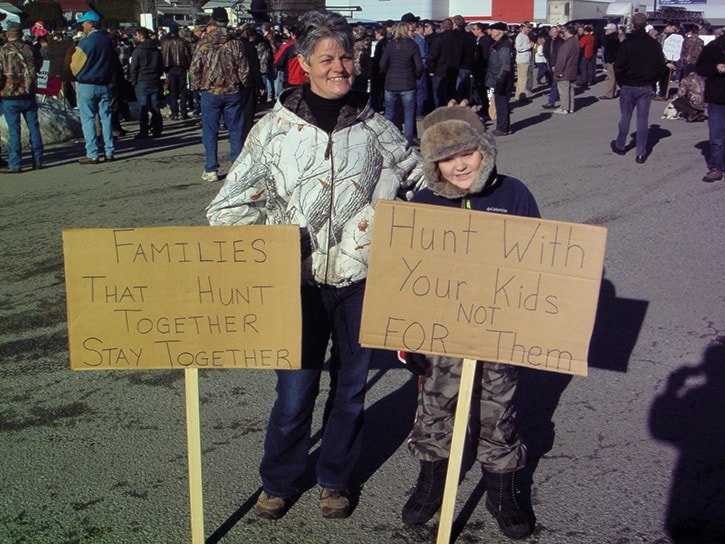Northern B.C. hunters opposed to changes to big game allocations are rallying public support, claiming the new policy favours guides and outfitters.
Under provincial policy, resident hunters and commercial guides receive a percentage split of the total number of animals allowed to be hunted in B.C., which are categorized by species and region.
For example, resident hunters might be allocated 75 per cent of moose allowed to be hunted in the north Skeena Region, while outfitters would receive 25 per cent.
On Feb. 6, Forests, Lands and Natural Resource Operations Minister Steve Thomson announced a revised version of an allocations policy implemented in December.
The revision came in response to outcry from resident hunters across the province, who said the percentage of animals given to commercial guides was too high.
The updated policy claims to transfer a total 60 animals across the province to outfitters, less than the December policy which would have given them more than 100.
But the change did little to reassure concerned resident hunters like Mike O’Neill, who believes the decision is part of a shift towards commercializing the sport.
The Smithers-based member of the Skeena Hunters’ Advisory Committee fears younger generations will not have the opportunities to hunt that he did growing up.
If the total number of animals allowed to be hunted in B.C. was reduced for conservation reasons, he said, the percentages in the policy might not be enough for non-commercial hunters.
For that reason, he said the government’s claim that the policy gives outfitters an additional 60 animals is incorrect.
“Some people will say, ‘well this isn’t going to affect you next year’,” said O’Neill.
“Well that doesn’t matter, if it’s going to affect us five years from now or 10 years from now and it’s legislated, now’s the time for us to stand up and say no this is not fair.”
O’Neill believes the ministry should revert to a policy it implemented in 2007 based on negotiations that started in 2003.
Measures from that policy were phased-in over a number of years, but in March 2011 the ministry received a report indicating that guides would be adversely affected by it.
The 2007 policy remained under review until December, when the minister announced new allocations.
Last month’s decision changed those ratios again.
The B.C. Wildlife Foundation represents resident hunters in B.C.
Regional director Mike Langegger believes a 90/10 split between resident hunters and outfitters respectively would be fair.
He too believes the policy will favour commercial guides in the long-term.
“When you have a business sector which is ultimately out there trying to privatize and, in my words ‘steal’, a common public property away from us we’re really having to shift our focus in defending our heritage right to hunt and B.C. families’ opportunities and really future generations,” said Langegger.
But Northwest Guide Outfitters Association vice-president Michael Young said outfitters were disappointed with the policy too.
Although the percentages under the Feb. 6 decision are close to what outfitters wanted, he said some outfitters had been hit hard hard by allocations introduced under the 2007 policy.
His organization had hoped the ministry would provide more financial support for guides affected by the changes.
“We’re not going to come out and say it’s good because we’ve got members who have been devastated by it,” he said.
He said the impact of minister Thomson’s revision was small.
According to Young’s calculations, the updated policy gives outfitters access to an additional 11.2 animals in the Skeena region.
Reg Collingwood from Smithers-based Collingwood Bros Guides and Outfitters believes the decision will have minimal impact for all hunters.
He said he did not understand the reaction from resident hunters.
“I just try and keep the positive stuff and keep that forward and I don’t bicker about a moose tag here and there because it depends what the winter is [how many animals die].
“A train can wipe out 11 moose in one night so when you put it all in perspective is it a big deal?”
Stikine NDP MLA Doug Donaldson does not believe the provincial government has accurate wildlife inventory numbers on which to base its decisions relating to hunting allocations.
“I think it starts with good science, it starts with respect which I don’t think has been shown to either the guide outfitters or the resident hunters, and it starts with looking at the current system,” he said.
Thomson stood by the decision, claiming it was balanced and considered the needs of both guides and residents while prioritizing the latter.
He said the figure of 60 animals was based on the number of animals available to harvest and how the allocations impacted each individual hunt.
Under the 2007 allocations, about 6,200 of the 7,550 big game animals allowed to be hunted are allocated to resident hunters, leaving 1,350 for guide outfitters.
The new decision would allocate 6,140 to resident hunters and 1,410 to guide outfitters.
Thomson said the ministry had abandoned the 2007 policy because research indicated it would have negative impacts on the outfitting industry.
“The decision was undertaken following extensive consultation with all user groups equally — both the guide outfitters and resident hunters,” he said.
“The final decision is a balanced decision that takes into consideration the needs of — both guides and residents, and maintains a policy of resident priority.”
The new percentage split for resident hunters/guides in the Skeena region:
Thin horn sheep: 60/40 %
Moose: 75/25 %
Mountain Goat: 65/35 %
Grizzly Bear: 60/40 %
Caribou: 75/25 %
